China Arts & Entertainment
Hong Kong Stars Shine in Call Me By Fire: ‘Greater Bay Area Brothers’ Go Viral on Chinese Social Media
The popularity of the ‘Greater Bay Area Brothers’ is part of a bigger trend of Hong Kong entertainers finding renewed success in mainland China.
Published
3 years agoon
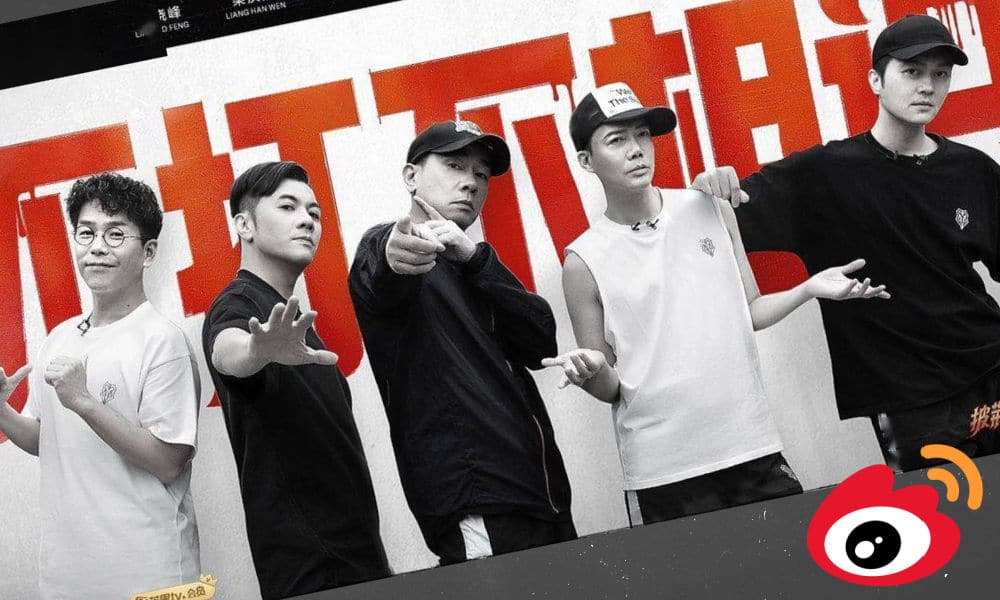
The Cantonese-speaking celebrities in the hit show Call Me By Fire have contributed to an increased social media interest in the Greater Bay Area, with some saying a ‘Hong Kong Music Revival’ is blossoming in the Chinese entertainment industry. Entertainers from Hong Kong are finding renewed success in mainland China.
Produced by Mango TV, the Chinese all-male variety show Call Me By Fire (披荆斩棘的哥哥) has concluded its super successful first season. With the last episode airing on October 29 of 2021, the show, starring 33 male celebrities, has brought some well-known Hong Kong actors and singers back into the spotlight in mainland China. On social media, they’ve been nicknamed “The Greater Bay Area Brothers” (“大湾区哥哥”) or “The Group of Greater Bay Area” (“大湾区组”).
The Greater Bay Area, also known as ‘Guangdong-Hong Kong-Macao Greater Bay Area’ (粤港澳大湾区) refers to the Chinese government’s scheme to link the cities of Hong Kong, Macau, and some cities in Guangdong Province including Guangzhou, Shenzhen, Zhuhai, Foshan, Zhongshan, Dongguan, Huizhou, Jiangmen, and Zhaoqing, into one major integrated economic and business hub.
In the Call Me By Fire variety show, male celebrities who’ve since long been active in the entertainment industry are competing to form a performance group. The five actors/singers from Hong Kong, including Chen Xiaochun (陈小春/Chan Siu Chun), Zhang Zhilin (张智霖/Cheung Chi-lam), Xie Tianhua (谢天华/Tse Tin-wah), Lin Xiaofeng (林晓峰/Lamb Hiu-fung) and Liang Hanwen (梁汉文/Leung Hon-man), have been in one group together ever since the first episode of the popular reality show.

(Zhang Zhilin, Lin Xiaofeng, Xie Tianhua, Chen Xiaochun, Liang Hanwen)
When group member Xie joked about their ‘too relaxed’ attitude in the first episode – while other people were busy practicing, – he referred to their group as “The Greater Bay Guys” (“大湾仔”). This seeded the concept to the audience, who adopted the term to refer to the team.
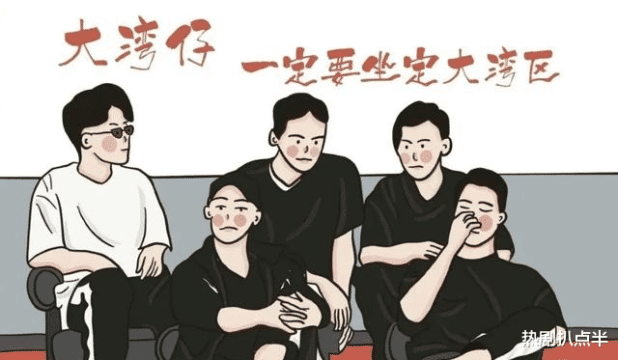
Illustration of The Greater Bay Guys, source http://dianyingfengyun.com/
On Chinese social media, the five Cantonese-speaking artists of the group then started to go viral as “The Greater Bay Area Brothers” (大湾区哥哥). Other Cantonese-speaking artists in the show including Huang Guanzhong (黄贯中/Wong Koon-chung) and Ouyang Jin (欧阳靖/Jin Au-Yeung aka MC Jin) also came to be regarded as ‘extra’ members of the group.
Various social media users call the success of the Greater Bay Brothers a sign of a greater “Hong Kong Music Revival” (“港乐复兴”). But the trend goes beyond music alone, as actors and comedians from Hong Kong are also increasingly moving to the mainland industry.
“The Greater Bay” Goes Trending
Recently. the the “Greater Bay Area” (大湾区) term was added to numerous Weibo hashtags relating to the show, garnering many views. Some examples:
- “The Aim of the Greater Bay Area Five is to Be Bigger and Stronger” (#大湾区五人组的目标是做大做强#)– 60 million views
- “The Five of the Greater Bay Area Are Soo Hilarious” (#被大湾区五人组笑死#) – 210 million views
- “All Members of the Greater Bay Area Team Act like They Have Social Phobia: (#大湾区全体社恐#) – 230 million views
- “LOL for the Greater Bay Area Team Choosing New Members” (#被大湾区选人笑死#) – 190 million views
- “LOL for the Greater Bay Area Team Speaking Mandarin” (#被大湾区的普通话笑死#) – 240 million views
- “Cantonese Rap by the Greater Bay Area Team” (#大湾区唱的粤语rap#) – 190 million views
- “The Water Stage of the Greater Bay Area Team Is Just So Cool” (#大湾区水舞台太酷了#) – 130 million views
- “The Greater Bay Area Brothers Recreate Iconic Scenes of the Show” (#大湾区哥哥再现名场面#) – 110 million views
The official data analysis tool of Sina Weibo, the Weibo Index (@微指数), shows that from August 12, when the first episode of the show aired, the trend volume for the “Greater Bay Area” (大湾区) started to peak.
Besides the Call Me By Fire show, other news about the Greater Bay area also contributed to this peak.
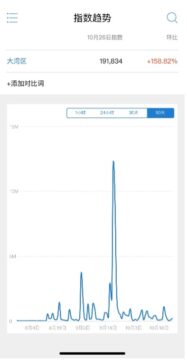
On August 26, the General Office of the State Council of the People’s Republic of China announced that Guangdong Province, Hong Kong, and Macau would host the 2025 National Games of China together.
Following the announcement on the closing ceremony of the 14th National Games of China in Xi’an, netizens made the Chief Executive of Hong Kong, Carrie Lam, go to the top trending lists with the hashtag “Carrie Lam Accepts the Flag of National Games of China” (#林郑月娥接过全运会会旗#) which received more than 100 million views.
Along with the hashtag created for Lam, another hashtag about the announcement using the ‘Greater Bay Area’ term also went trending that day and received more than 170 million views (“2025 National Games to Be Held in the Greater Bay Area” #2025全运会将在大湾区举办#).
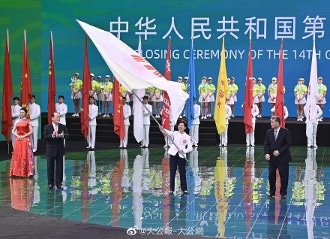
The recent social media trend peak for ‘Greater Bay Area’ occurred on September 21, the night of the Mid-Autumn Festival, when a concert was simultaneously held in Shenzhen (main venue) and Hong Kong (sub-venue). The concert was live-streamed on national platforms and shown in Hong Kong by public broadcasters. The hashtag of the concert, “The Full Moon Rises in the Great Bay Area” (#湾区升明月#), received over 1.38 billion (!) views.
The ‘Greater Bay Brothers’ were also invited to perform at the concert, along with many other singers from mainland China, Hong Kong, Macau, and Taiwan. More than one-third of the songs performed at the concert were in Cantonese. A Hong Kong movies montage of clips also quickly went viral on Weibo, leading Chinese netizens to share memories of watching these movies again and again.
All of these recent trending topics show how much Cantonese songs and movies resonate with netizens in mainland China. Especially for those born in the 1970-1990 era, Hong Kong popular culture has become a part of their childhood memories.
Finding Renewed Success in the Mainland
The five members of the Greater Bay Group in Call Me By Fire and its extra Cantonese-speaking members are mostly known by the mainland audience because of their songs or for the drama series or films they starred in.
For example, Huang Guanzhong is known as a member of the legendary band Beyond, while Chen Xiaochun became popular because of his role as Wei Xiaobao (韦小宝) in the TV drama The Deer and the Cauldron (鹿鼎记), and for playing “Chicken” Chiu (山鸡哥) in the Young and Dangerous film series (古惑仔系列电影). His songs, Heartless You (算你恨) and Exclusive Memory (独家记忆) were also very popular in mainland China in the early 2000s.
Zhang Zhilin is widely known by audiences in mainland China due to his role in The Legend of the Condor Heroes (射雕英雄传) produced by TVB in 1994. Other TV dramas such as Return of the Cuckoo (十月初五的月光) and Triumph in the Skies II (冲上云霄2) further boosted his popularity in the mainland.
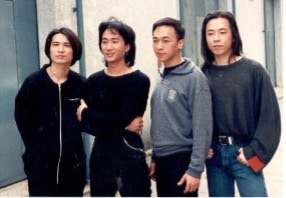
The legendary band Beyond, the first one on the right is Huang Guanzhong.

Chen Xiaochun in “The Deer and the Cauldron” as Wei Xiaobao, and in the “Young and Dangerous” Film Series as “Chicken” Chiu.

Zhang Zhilin in “The Legend of the Condor Heroes” as Guo Jing (郭靖), and in the “Triumph in the Skies II” as Captain Cool.
There was a time when singers or actors in mainland China, including the two other Greater Bay Area Brothers Zhao Wenzhuo (赵文卓) and Zhang Jin (张晋), would move to Hong Kong for better career development. Along with the fast developments of the entertainment industry in mainland China, things have changed. Some Hong Kong artists have now begun to shift their career focus to mainland China.
One example is the Hong Kong actress Sheh Shiman (佘诗曼, also known as Charmaine Sheh), who started her career by winning second runner-up in the 1997 Miss Hong Kong pageant. She stood out for her roles in Return of the Cuckoo in 2000 (partnering with Zhang Zhilin) and War and Beauty (金枝欲孽) in 2004.

Sheh Shiman and Zhang Zhilin in Return of the Cuckoo.
In 2011, Sheh decided not to renew her long-term contract with TVB, and started to focus more on acting in TV dramas in mainland China. In 2018, she starred in the hugely popular The Story of Yanxi Palace and gained many fans in the mainland for her acting skills. She was also nominated for Best Supporting Actress at the 24th Huading Awards – China’s equivalent to the American People’s Choice Awards.
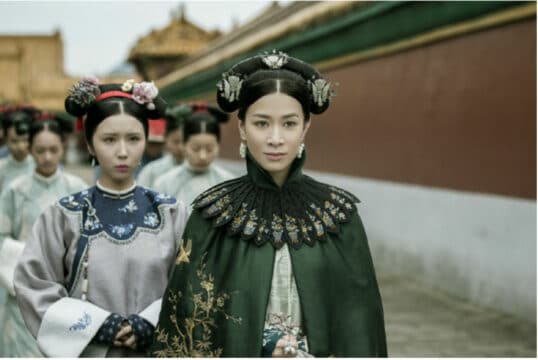
Sheh Shiman in the Story of Yanxi Palace.
Another example of a Hong Kong entertainer achieving new career success in mainland China is Wang Zulan (王祖蓝/Wong Cho-lam). As a comedian, Wang has been participating in various variety shows. He is well known by the mainland audience for impersonating different celebrities or story characters.
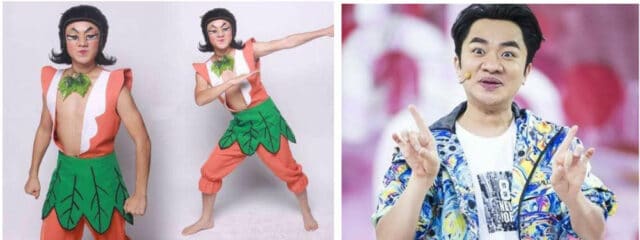
In March 2018, a group of senior Hong Kong artists set up the Association for Betterment of Hong Kong’s Entertainment Industry in Mainland China (HKEIMC) in Hong Kong in the hope of becoming a bridge between the mainland and Hong Kong, Macau, and promoting more exchanges and cooperation within the entertainment industry.
The HKEIMC also aims to help the development of Hong Kong and Macao artists in mainland China, with Jacky Chan (成龙) as the chairman and Zeng Zhiwei (曾志伟/Tsang Chi Wai) as the executive chairman.
Talking about the founding of HKEIMC, Vice President Wang Mingquan (汪明荃/Wang Ming-chun) said that most of the local residents in the Greater Bay Area already communicate in Cantonese and watch Hong Kong TV programs, suggesting that the cultural differences are relatively small and that there is more room for cooperation.
The entertainment industry in Hong Kong has recently shown more signs of moving to the mainland. Earlier in 2021, for example, Emperor Entertainment Group (EEG), one of the largest entertainment groups in Hong Kong, announced the opening of its Greater Bay Area headquarter office in Guangzhou.
More Greater Bay Coming to China’s Mainstream Entertainment
As Call Me By Fire has geared up the audience’s huge interest in the Greater Bay Area, it is reported that a new variety show featuring the five brothers of the Greater Bay Area named Nights of the Greater Bay Guys (大湾仔的夜) has already started filming.
In addition, audiences interested in Cantonese songs can also expect a new singing show which will be co-produced by Mango TV and TVB. The producer of the show, Wang Zulan, said in a recent interview that he will bring his ten years of experience in the mainland back to Hong Kong and the Greater Bay Area at large.
All of these recent developments are signs of a more flourishing future for the entertainment industry in mainland China, presenting more job opportunities for artists from Hong Kong.
“As Hong Kong singers are gathering in mainland variety shows and the Greater Bay Brothers are now going viral across the country, is this the 2021 beginning of the great ‘Cantopop’ revival?”, some Weibo users wonder. It may very well be.
By Wendy Huang
Follow @whatsonweibo
Spotted a mistake or want to add something? Please let us know in comments below or email us. Please note that your comment below will need to be manually approved if you’re a first-time poster here.
©2021 Whatsonweibo. All rights reserved. Do not reproduce our content without permission – you can contact us at info@whatsonweibo.com
Wendy Huang is a China-based Beijing Language and Culture University graduate who currently works for a Public Relations & Media software company. She believes that, despite the many obstacles, Chinese social media sites such as Weibo can help Chinese internet users to become more informed and open-minded regarding various social issues in present-day China.
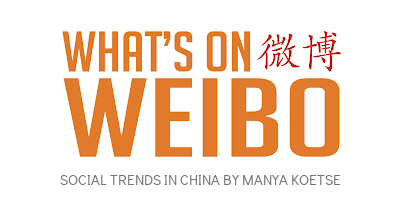
Also Read
China Arts & Entertainment
Singing Competition or Patriotic Fight? Hunan TV’s ‘Singer 2024’ Stirs Nationalistic Sentiments
“I’m in Zibo eating barbecue, I really don’t feel like listening to Alicia Keys.” Hunan TV’s ‘Singer 2024’ has set off a new wave of national pride in China’s music and performers.
Published
2 months agoon
May 17, 2024By
Ruixin Zhang
Besides memes and jokes, Hunan TV’s ‘Singer 2024’ has set off a new wave of national pride in China’s music and performers on Chinese social media.
In May, while the whole of Europe was gripped by the Eurovision Song Contest frenzy, Chinese audiences were eagerly anticipating the return of their own beloved singing competition, Singer 2024 (@湖南卫视歌手), formerly known as I Am a Singer (我是歌手).
The show, introduced from South Korea’s MBC Television and popular in China since 2013, only features professional singers who have already made a name for themselves.
Rather than watching unknown aspiring singers who are hoping to be discovered in many singing competitions, such as Sing! China, Singer 2024 gives audiences a show filled with professional and often stunning show performances by established names in the entertainment industry.
Since 2013, renowned singers from China and abroad have appeared on the show, including Chinese vocalist Tan Jing (谭晶), British pop singer Jessie J, and the late Hong Kong pop diva Coco Lee. However, no season managed to create as many waves as the 2024 season did, dominating all social media trending topics overnight.
So, what exactly happened?
COMPETING WITH FOREIGNERS
“The difference between the Grammys and the Strawberry Musical Festival”
In early May, the pre-show promotion of Singer 2024 was already buzzing on Chinese social media after a list of featured singers appeared on Weibo, including big names such as American singer-songwriter Bruno Mars, Korean-New Zealand singer Rosé from Blackpink, and Japanese diva LiSA.
Although Singer previously had many foreign singers on the show, this international celebrity lineup still caused a stir.
On the day of the first episode, only two foreign singers were announced to appear on the show: young Moroccan-Canadian singer Faouzia and the Grammy-nominated American singer-songwriter Chanté Moore. The other contestants were all Chinese singers who are already well-known among Chinese audiences. Because many people were unfamiliar with the two foreign singers, they joked that the winner of this season was already set in stone; surely it would be the famous Chinese singer Na Ying (那英), known for her beautiful voice.
However, that first episode surprised everyone as the two foreign singers, Faouzia and Chanté Moore, showed outstanding vocal skills. This not only startled many viewers but also made the Chinese contestants uneasy. Several experienced Chinese singers apparently were so unnerved after watching Faouzia and Chanté Moore’s performance that their voices trembled when singing.

Since the show was broadcast live – without post-production editing or autotune – audiences got to hear the actual vocal capabilities and see performers’ genuine reactions. It seemed undeniable that the foreign contestants did much better in terms of vocals and stage presence than the Chinese ones. Some online commenters even said that the gap between Chinese and foreign singers’ levels was like “the difference between the Grammys and the Strawberry Musical Festival” [a local Chinese music festival].
Chinese online influencer Yongkai (@陈咏开165) shared screenshots of Chanté Moore’s backstage reactions during the show. The American celebrity seemed puzzled when hearing the somewhat underwhelming performance by Chinese singer Yang Chenglin (楊丞琳), and she appeared much more positive when Na Ying sang.

This noteworthy scene, coupled with Chanté’s comments during an interview saying that she thought the Chinese production team had invited her on the show to be a judge, turned the entire show into a display of foreign singers outshining the Chinese contestants.
By the end of the first episode, Chanté Moore and Faouzia unsurprisingly ranked first and second, with Na Ying in third place.

After the show, some online commenters jokingly pointed out that Na Ying, being of Manchu descent like the rulers of China during the Qing Dynasty, showed some similarities to Empress Dowager Cixi’s defiance against Western colonizers in the way she “single-handedly took up against on foreigners” on the show.
They humorously turned Na Ying’s expressions into memes resembling Empress Dowager Cixi from an old Chinese TV show, with captions like “I want the foreigners dead” (“我要洋人死”).

Others suggested finding better Chinese singers for the show who could compete with Faouzia and Moore.
“SINGING WELL” CULTURALLY COLONIZED?
“I’m in Zibo eating BBQ, I really don’t want to listen to Alicia Keys.”
Initially, discussions about the show were light-hearted and humorous, until some netizens who couldn’t appreciate the jokes began to dampen the mood and made online discussions more serious.
Zou Xiaoying (@邹小樱), a music critic with nearly two million followers, posted on social media after the show, stating that he would have never voted for Chanté Moore or Faouzia. Not only did Zou question their vocal talent, he also wondered if the aesthetic of Chinese listeners had been influenced by Western music taste to such an extent that it has been “culturally colonized” (“文化殖民”). Meanwhile, he praised the members of Beijing rock band Second Hand Rose as “national heroes” (“民族英雄”).
He wrote:
If I had three votes for the first episode of “Singer 2024,” I’d vote for Second Hand Rose, Na Ying, and Silence Wang [note: Chinese singer-songwriter and record producer Wang Sushuang 汪苏泷]. The reason I wouldn’t vote for Chanté Moore or Faouzia is because — do they actually sing so well?
Has our definition of “singing well” perhaps been colonized? Just as our modern-day use of Chinese has little to do with our classical Chinese poems, with the foundation of modern Chinese actually being translations from the 20th century, is this also a form of ‘cultural colonization’?
You must think I’m talking nonsense again. But when I listen to Chanté Moore singing “If I Ain’t Got You,” I find it too boring. I know her singing is “good,” but this “good” has nothing to do with me. If, for Chinese listeners, Chanté Moore’s “good” is the standard, then is that what we in the music industry should be working towards? Isn’t that funny? When you open QQ Music or NetEase Cloud Music, and it recommends these songs to you every day, won’t you be convinced to practice again?
Of course, I know Chanté Moore is in good shape, very relaxed. Actually all of the Chinese singers tonight were very nervous. Yang Chenglin (杨丞琳) was nervous, Na Ying was also nervous. Even a seemingly carefree band like Second Hand Rose, if you listened to the introduction of their song, [you’ll find] they were so nervous that Yao Lan, supposedly “China’s No.1 Guitarist”, was so nervous that he hit the wrong note. It was not even a fast-paced solo (…), how nervous could he be? When everyone’s so tense, the confidence of Chanté Moore and Faouzia is indeed something that East Asia can’t match. In East-Asian [entertainment] circles, represented by China/Japan/Korea, our different cultural habits, upbringing, and ethnic characteristics have made it so that we don’t possess these kinds of singing abilities, even including our ways of emotional expression. I don’t know from which season it started with ‘Singer’ – and if it’s some kind of Catfish Effect (鲶鱼效应 ) – that they brought international singers with different cultural backgrounds into the competition. But this isn’t the Olympics, it’s not like Liu Xiang [刘翔, Chinese gold medal hurdler] is going to defeat opponents from the United States or Cuba. “I’m in Zibo eating barbecue, I really don’t feel like Alicia Keys.” (This line is not mine, I stole it from my WeChat friend).
Because of this, I find Second Hand Rose even more rare and precious. It’s just like I used to love asking: If you could only recommend one Chinese band to your foreign friends, which one would you recommend? Some say it’s New Pants (新裤子), some say it’s Omnipotent Youth Society, but my answer will always be Second Hand Rose. ‘The drama of Monkey King is a national treasure,’ its light will always shine. Facing the gunfire of Western powers, Second Hand Rose is standing on the frontline, they are our national heroes. Indeed, the band itself was nervous, (..), but when Chanté Moore goes off like a singing dolphin, we are fortunate to have Second Hand Rose at the frontline; the Chinese sons and daughters are building the Great Wall of Music of flesh and blood.
Because of this, I find Second Hand Rose even more rare and precious. It’s just like I used to love asking: If you could only recommend one Chinese band to your foreign friends, which one would you recommend? Some say it’s New Pants (新裤子), some say it’s Omnipotent Youth Society, but my answer will always be Second Hand Rose. ‘The drama of Monkey King is a national treasure,’ its light will always shine. Facing the gunfire of Western powers, Second Hand Rose is standing on the frontline, they are our national heroes. Indeed, the band itself was nervous, (..), but when Chanté Moore goes off like a singing dolphin, we are fortunate to have Second Hand Rose at the frontline; the Chinese sons and daughters are building the Great Wall of Music of flesh and blood.
Anyway, no matter if they’re strong or not, I would never vote for the foreigner.
The comment about ‘I’m in Zibo eating barbecue, I really don’t feel like [listening to] Alicia Keys’ refers to the craze surrounding China’s ‘BBQ town’ Zibo. In Zibo, Chinese visitors like to sing, drink beer, and enjoy food together; it’s a simple and modest way of appreciating life and music, which contrasts with slick and smooth American or foreign styles of performing and singing.
Whether Zou’s criticism was for attention or genuine sentiment, it shifted the focus of the discussion from music to patriotism.
CHINESE SINGERS WITH MILITARISTIC UNDERTONES
“I volunteer to join the battle”
Amidst all this, some netizens, easily swayed by nationalist sentiments, began to seek help from the “national team” (国家队) of singers — musicians employed by national-level arts troupes — to “bring glory to the nation” and teach the foreigners a lesson. Some even questioned the intentions of the Singer 2024 TV show in inviting foreign singers to participate.
On May 12th, renowned Chinese singer and philanthropist Han Hong (韩红) posted on Weibo, fueling a wave of sentiment and support. In her post, Han Hong declared, “I am Chinese singer Han Hong, and I volunteer to join the battle,” tagging the production team of the TV show. Her invitation to join the battle quickly went viral.

Han Hong meme: “Who called for me?”
Han Hong has significant influence in the Chinese music industry and society as a whole. Her usual serious demeanor and avoidance of internet pop culture made netizens unsure whether she was joking or serious. Nevertheless, regardless of her intentions, a group of well-known singers began to volunteer via Weibo, emphasizing their identity as “Chinese singers” and using phrases with strong militaristic undertones like “fighting for the country” and “answering the call.”
Although many enjoyed this new wave of national pride in Chinese music and performers, some netizens criticized the trend of transforming an entertainment show into a nationalistic competition.
Film critic He Xiaoqin (何小沁) stated, “It’s okay to take the Qing-Dynasty-fighting-foreigners comparison as a joke, but taking it too seriously in today’s context is absurd.”
Others expressed fatigue with how quickly topics on Chinese internet platforms escalate to patriotic sentiments. To bring the focus back to entertainment, they turned “I volunteer to join the battle” (#我请战#) into a new internet catchphrase.
In response, the production team of Singer 2024 released a statement on Weibo, thanking all the singers for their self-recommendations. They emphasized the show’s competitive structure but clarified that “winning” is just one part of a singer’s journey..but that the love of music goes beyond all in connecting people, no matter where they’re from.
By Ruixin Zhang, edited with further input by Manya Koetse
Independently reporting China trends for over a decade. Like what we do? Support us and get the story behind the hashtag by subscribing:
Spotted a mistake or want to add something? Please let us know in comments below or email us. First-time commenters, please be patient – we will have to manually approve your comment before it appears.
©2024 Whatsonweibo. All rights reserved. Do not reproduce our content without permission – you can contact us at info@whatsonweibo.com.
China Arts & Entertainment
“Old Bull Eating Young Grass”: 86-Year-Old Chinese Painter Fan Zeng Marries 36-Year-Old Xu Meng
Online reactions to the news of Fan’s marriage to Xu Meng, his fourth wife, reveal that the renowned artist is not particularly well-liked among Chinese netizens.
Published
3 months agoon
April 18, 2024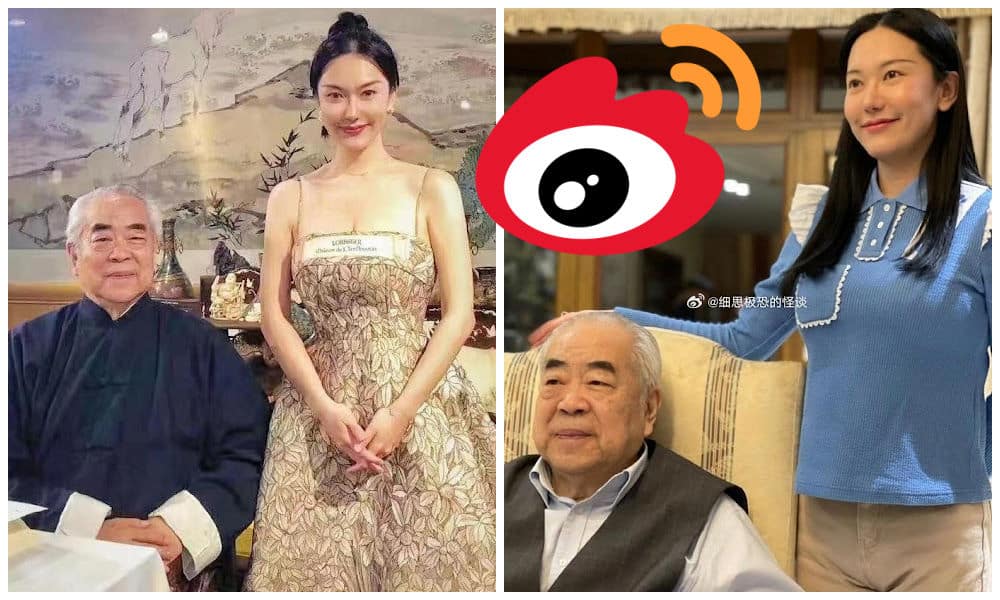
The recent marriage announcement of the renowned Chinese calligrapher/painter Fan Zeng and Xu Meng, a Beijing TV presenter 50 years his junior, has sparked online discussions about the life and work of the esteemed Chinese artist. Some netizens think Fan lacks the integrity expected of a Chinese scholar-artist.
Recently, the marriage of a 86-year-old Chinese painter to his bride, who is half a century younger, has stirred conversations on Chinese social media.
The story revolves around renowned Chinese artist, calligrapher, and scholar Fan Zeng (范曾, 1938) and his new spouse, Xu Meng (徐萌, 1988). On April 10, Fan announced their marriage through an online post accompanied by a picture.
In the picture, Fan is seen working on his announcement in calligraphic form.
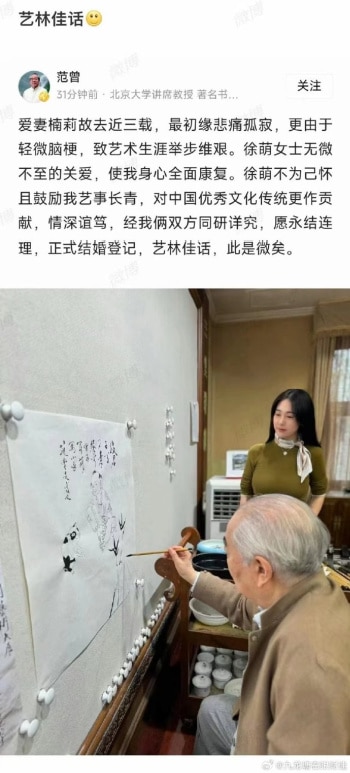
Fan Zeng announces his marriage on Chinese social media.
In his writing, Zeng shares that the passing of his late wife, three years ago, left him heartbroken, and a minor stroke also hindered his work. He expresses gratitude for Xu Meng’s care, which he says led to his physical and mental recovery. Zeng concludes by expressing hope for “everlasting harmony” in their marriage.
Fan Zeng is a calligrapher and poet, but he is primarily recognized as a contemporary master of traditional Chinese painting. Growing up in a well-known literary family, his journey in art began at a young age. Fan studied under renowned mentors at the Academy of Fine Arts in Beijing, including Wu Zuoren, Li Keran, Jiang Zhaohe, and Li Kuchan.
Fan gained global acclaim for his simple yet vibrant painting style. He resided in France, showcased his work in numerous exhibitions worldwide, and his pieces were auctioned at Sotheby’s and Christie’s in the 1980s.[1] One of Fan’s works, depicting spirit guardian Zhong Kui (钟馗), was sold for over 6 million yuan (828,000 USD).
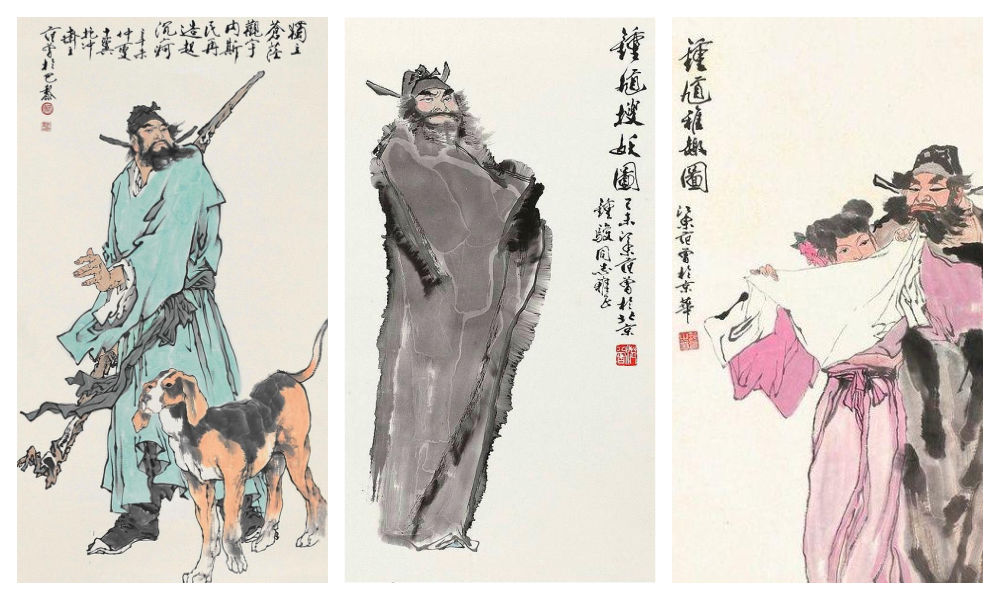
Zhong Kui in works by Fan Zeng.
In his later years, Fan Zeng transitioned to academia, serving as a lecturer at Nankai University in Tianjin. At the age of 63, he assumed the role of head of the Nankai University Museum of Antiquities, as well as holding various other positions from doctoral supervisor to honorary dean.
By now, Fan’s work has already become part of China’s twentieth-century art history. Renowned contemporary scholar Qian Zhongshu once remarked that Fan “excelled all in artistic quality, painting people beyond mere physicality.”
A questionable “role model”
Fan’s third wife passed away in 2021. Later, he got to know Xu Meng, a presenter at China Traffic Broadcasting. Allegedly, shortly after they met, he gifted her a Ferrari, sparking the beginning of their relationship.
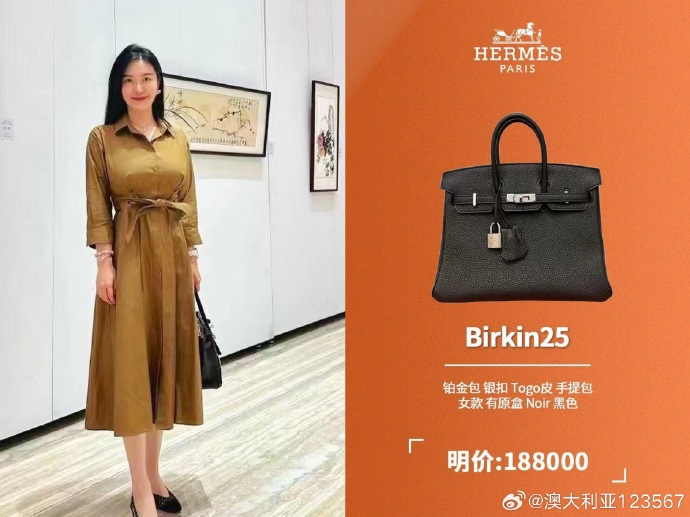
A photo of Xu and her Hermes Birkin 25 bag has also been making the rounds on social media, fueling rumors that she is only in it for the money (the bag costs more than 180,000 yuan / nearly 25,000 USD).
On Weibo, reactions to the news of Fan’s marriage to Xu Meng, his fourth wife, reveal that the renowned artist is not particularly well-liked among netizens. Despite Fan’s reputation as a prominent philanthropist, many perceive his recent marriage as yet another instance of his lack of integrity and shamelessness.

Fan Zeng and Xu Meng. Image via Weibo.
One popular blogger (@好时代见证记录者) sarcastically wrote:
“Warm congratulations to the 86-year-old renowned contemporary erudite scholar and famous calligrapher Fan Zeng, born in 1938, on his marriage to Ms Xu Meng, a 50 years younger 175cm tall woman who is claimed to be China’s number one golden ratio beauty. Mr Fan Zeng really is a role model for us middle-aged greasy men, as it makes us feel much less uncomfortable when we’re pursuing post-90s youngsters as girlfriends and gives us an extra shield! Because if contemporary Confucian scholars [like yourself] are doing this, then we, as the inheritors of Confucian culture, can surely do the same!“
Various people criticize the fact that Xu Meng is essentially just an aide to Fan, as she can often be seen helping him during his work. One commenter wrote: “Couldn’t he have just hired an assistant? There’s no need to turn them into a bed partner.”
Others think it’s strange for a supposedly scholarly man to be so superficial: “He just wants her for her body. And she just wants him for his inheritance.”
“It’s so inappropriate,” others wrote, labeling Fan as “an old bull grazing on young grass” (lǎoniú chī nèncǎo 老牛吃嫩草).
Fan is not the only well-known Chinese scholar to ‘graze on young grass.’ The famous Chinese theoretical physicist Yang Zhenning (杨振宁, 1922), now 101 years old, also shares a 48-year age gap with his wife Weng Fen (翁帆). Fan, who is a friend of Yang’s, previously praised the love between Yang and Weng, suggesting that she kept him youthful.
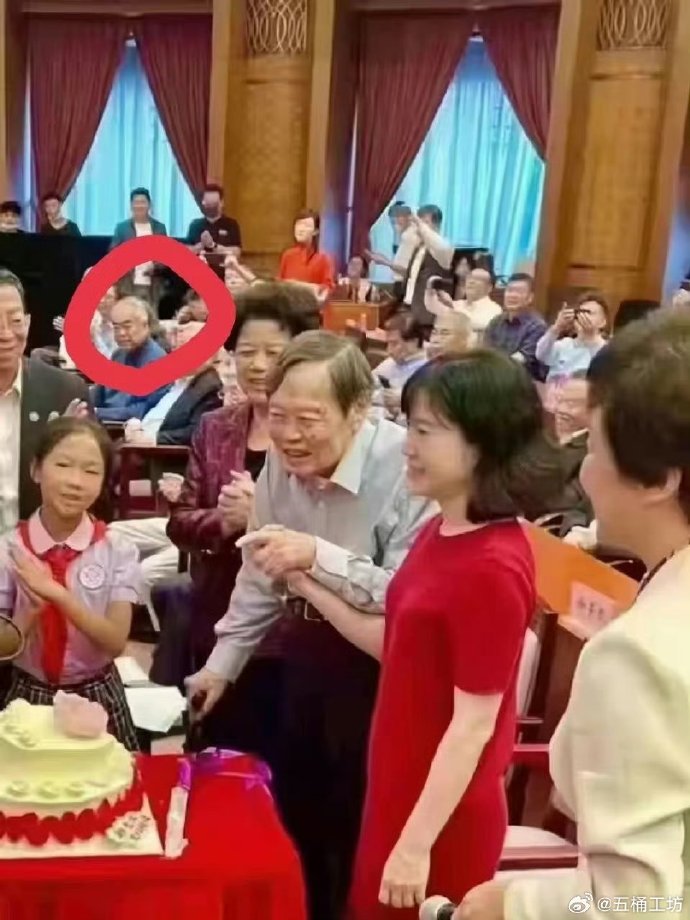
Older photo posted on social media, showing Fan attending the wedding ceremony of Yang Zhenning and his 48-year-younger partner Weng Fen.
Some speculate that Fan took inspiration from Yang in marrying a significantly younger woman. Others view him as hypocritical, given his expressions of heartbreak over his previous wife’s passing, and how there’s only one true love in his lifetime, only to remarry a few years later.
Many commenters argue that Fan Zeng’s conduct doesn’t align with that of a “true Confucian scholar,” suggesting that he’s undeserving of the praise he receives.
“Mr. Wang from next door”
In online discussions surrounding Fan Zeng’s recent marriage, more reasons emerge as to why people dislike him.
Many netizens perceive him as more of a money-driven businessman rather than an idealistic artist. They label him as arrogant, critique his work, and question why his pieces sell for so much money. Some even allege that the only reason he created a calligraphy painting of his marriage announcement is to profit from it.
Others cast doubt on his status as a Chinese calligraphy ‘grandmaster,’ noting that his calligraphy style is not particularly impressive and may contain typos or errors. His wedding announcement calligraphy appears to blend traditional and simplified characters.

Netizens have pointed out what looks like errors or typos in Fan’s calligraphy.
Another source of dislike stems from his history of disloyalty and his feud with another prominent Chinese painter, Huang Yongyu (黄永玉). Huang, who passed away in 2023, targeted Fan Zeng in some of his satirical paintings, including one titled “When Others Curse Me, I Also Curse Others” (“人骂我,我亦骂人”). He also painted a parrot, meant to mock Fan Zeng’s unoriginality.
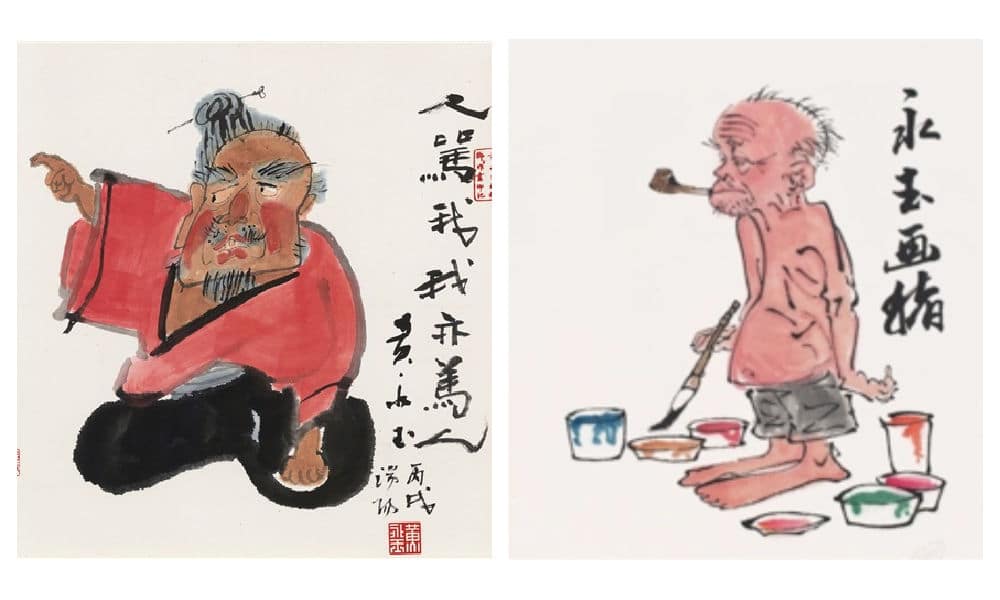
Huang Yongyu made various works targeting Fan Zeng.
In retaliation, Fan produced his own works mocking Huang, sparking an infamous rivalry in the Chinese art world. The two allegedly almost had a physical fight when they ran into each other at the Beijing Hotel.
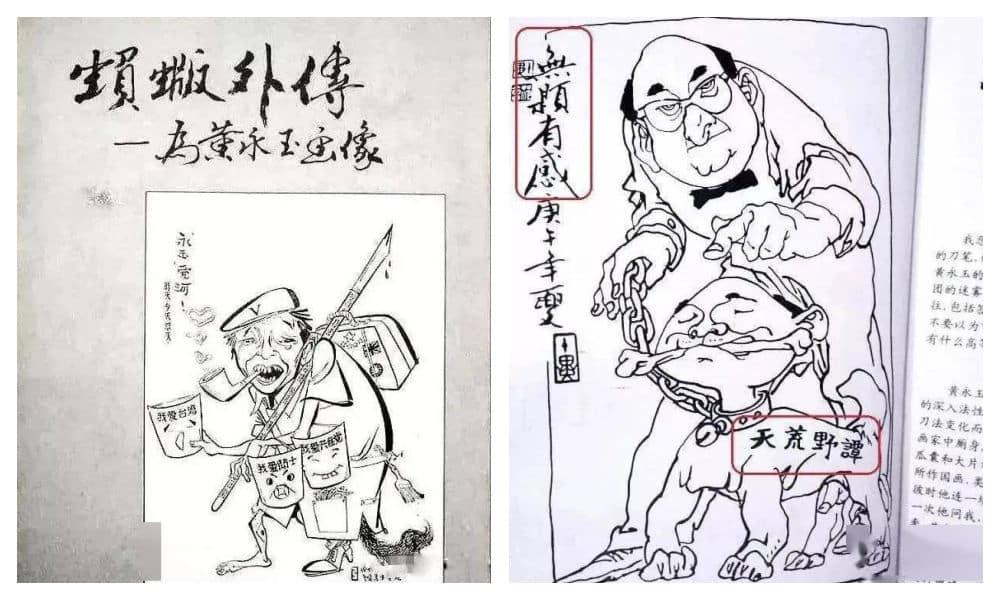
Fan Zeng mocked Huang Yongyu in some of his works.
Fan and Huang were once on good terms though, with Fan studying under Huang at the Central Academy of Fine Arts in Beijing. Through Huang, Fan was introduced to the renowned Chinese novelist Shen Congwen (沈从文, 1902-1988), Huang’s first cousin and lifelong friend. As Shen guided Fan in his studies and connected him with influential figures in China’s cultural circles, their relationship flourished.
However, during the Cultural Revolution, when Shen was accused of being a ‘reactionary,’ Fan Zeng turned against him, even going as far as creating big-character posters to criticize his former mentor.[2] This betrayal not only severed the bond between Shen and Fan but also ended Fan’s friendship with Huang, and it is still remembered by people today.
Fan Zeng’s behavior towards another former mentor, the renowned painter Li Kuchan (李苦禪, 1899-1983), was also controversial. Once Fan gained fame, he made it clear that he no longer respected Li as his teacher. Li later referred to Fan as “a wolf in sheep’s clothes,” and apparently never forgave him. Although the exact details of their falling out remain unclear, some blame Fan for exploiting Li to further his own career.
There are also some online commenters who call Fan Zeng a “Mr Wang from next door” (隔壁老王), a term jokingly used to refer to the untrustworthy neighbor who sleeps with one’s wife. This is mostly because of the history of how Fan Zeng met his third wife.
Fan’s first wife was the Chinese female calligrapher Lin Xiu (林岫), who came from a wealthy family. During this marriage, Fan did not have to worry about money and focused on his artistic endeavours. The two had a son, but the marriage ended in divorce after a decade. Fan’s second wife was fellow painter Bian Biaohua (边宝华), with whom he had a daughter. It seems that Bian loved Fan much more than he loved her.
It is how he met his third wife that remains controversial to this day. Nan Li (楠莉), formerly named Zhang Guiyun (张桂云), was married to performer Xu Zunde (须遵德). Xu was a close friend of Fan, and helped him out when Fan was still poor and trying to get by while living in Beijing’s old city center.
Wanting to support Fan’s artistic talent, Xu let Fan Zeng stay over, supported him financially, and would invite him for meals. Little did he know that while Xu was away to work, Fan enjoyed much more than meals alone; Fan and Xu’s wife engaged in a secret decade-long affair.
When the affair was finally exposed, Xu Zunde divorced his wife. Still, they would use his house to meet and often locked him out. Three years later, Nan Li officially married Fan Zeng. Xu not only lost his wife and friend but also ended up finding his house emptied, his two sons now bearing Fan’s surname.
When Nan Li passed away in 2021, Fan Zeng published an obituary that garnered criticism. Some felt that the entire text was actually more about praising himself than focusing on the life and character of his late wife, with whom he had been married for forty years.
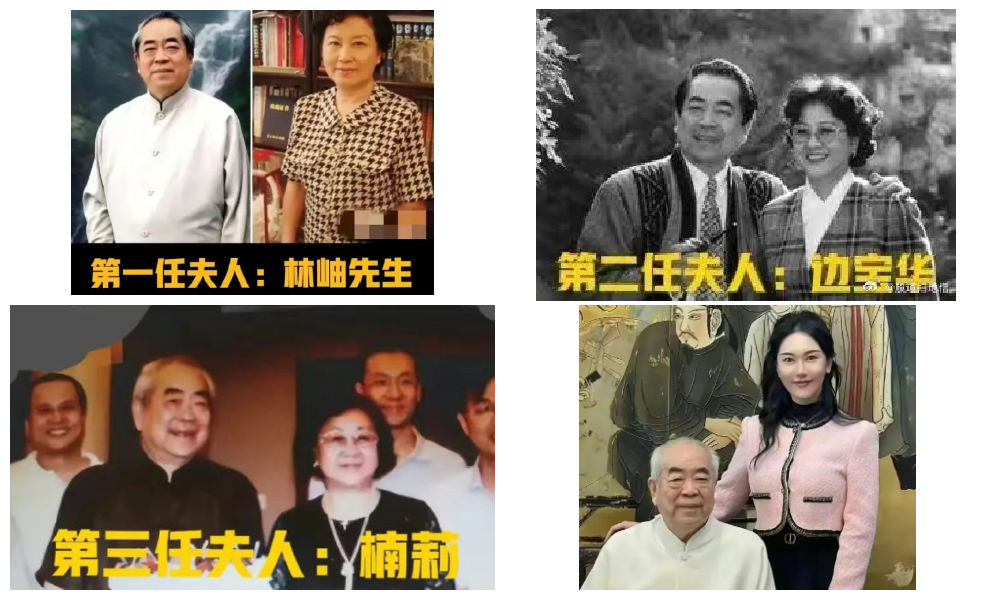
Fan Zeng and his four wives
An ‘old pervert’, a ‘traitor’, a ‘disgrace’—there are a lot of opinions circulating about Fan that have come up this week.
Despite the negativity, a handful of individuals maintain a positive outlook. A former colleague of Xu Meng writes: “If they genuinely like each other, age shouldn’t matter. Here’s to wishing them a joyful marriage.”
By Manya Koetse
[1]Song, Yuwu. 2014. Biographical Dictionary of the People’s Republic of China. United Kingdom: McFarland & Company, 76.
[2]Xu, Jilin. 2024. “Xu Jilin: Are Shen Congwen’s Tears Related to Fan Zeng?” 许纪霖:沈从文的泪与范曾有关系吗? The Paper, April 15. https://www.thepaper.cn/newsDetail_forward_27011031. Accessed April 17, 2024.
Independently reporting China trends for over a decade. Like what we do? Support us and get the story behind the hashtag by subscribing:
Spotted a mistake or want to add something? Please let us know in comments below or email us. First-time commenters, please be patient – we will have to manually approve your comment before it appears.
©2024 Whatsonweibo. All rights reserved. Do not reproduce our content without permission – you can contact us at info@whatsonweibo.com.
Subscribe

Weibo Watch: The Future is Here

“Bye Bye Biden”: Biden’s Many Nicknames in Chinese

Enjoying the ‘Sea’ in Beijing’s Ditan Park

A Triumph for “Comrade Trump”: Chinese Social Media Reactions to Trump Rally Shooting

Weibo Watch: Get Up, Stand Up

The Tragic Story of “Fat Cat”: How a Chinese Gamer’s Suicide Went Viral

“Old Bull Eating Young Grass”: 86-Year-Old Chinese Painter Fan Zeng Marries 36-Year-Old Xu Meng

A Brew of Controversy: Lu Xun and LELECHA’s ‘Smoky’ Oolong Tea

Singing Competition or Patriotic Fight? Hunan TV’s ‘Singer 2024’ Stirs Nationalistic Sentiments

Zara Dress Goes Viral in China for Resemblance to Haidilao Apron

Weibo Watch: The Battle for the Bottom Bed

About the “AI Chatbot Based on Xi Jinping” Story

China’s Intensified Social Media Propaganda: “Taiwan Must Return to Motherland”

Weibo Watch: Telling China’s Stories Wrong

Saying Goodbye to “Uncle Wang”: Wang Wenbin Becomes Chinese Ambassador to Cambodia
Get in touch
Would you like to become a contributor, or do you have any tips or suggestions? Get in touch here!
Popular Reads
-
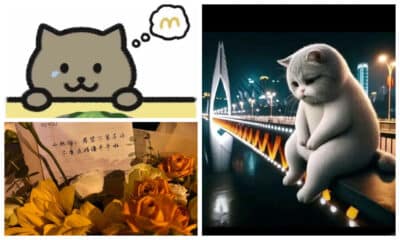
 China Insight3 months ago
China Insight3 months agoThe Tragic Story of “Fat Cat”: How a Chinese Gamer’s Suicide Went Viral
-

 China Music4 months ago
China Music4 months agoThe Chinese Viral TikTok Song Explained (No, It’s Not About Samsung)
-
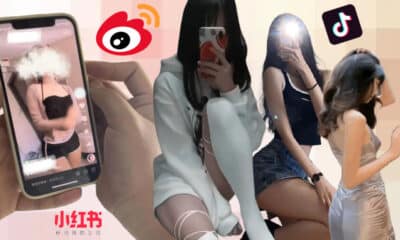
 China Digital10 months ago
China Digital10 months agoToo Sexy for Weibo? Online Discussions on the Concept of ‘Cābiān’
-

 China Arts & Entertainment12 months ago
China Arts & Entertainment12 months agoBehind 8 Billion Streams: Who is Dao Lang Cursing in the Chinese Hit Song ‘Luocha Kingdom’?




